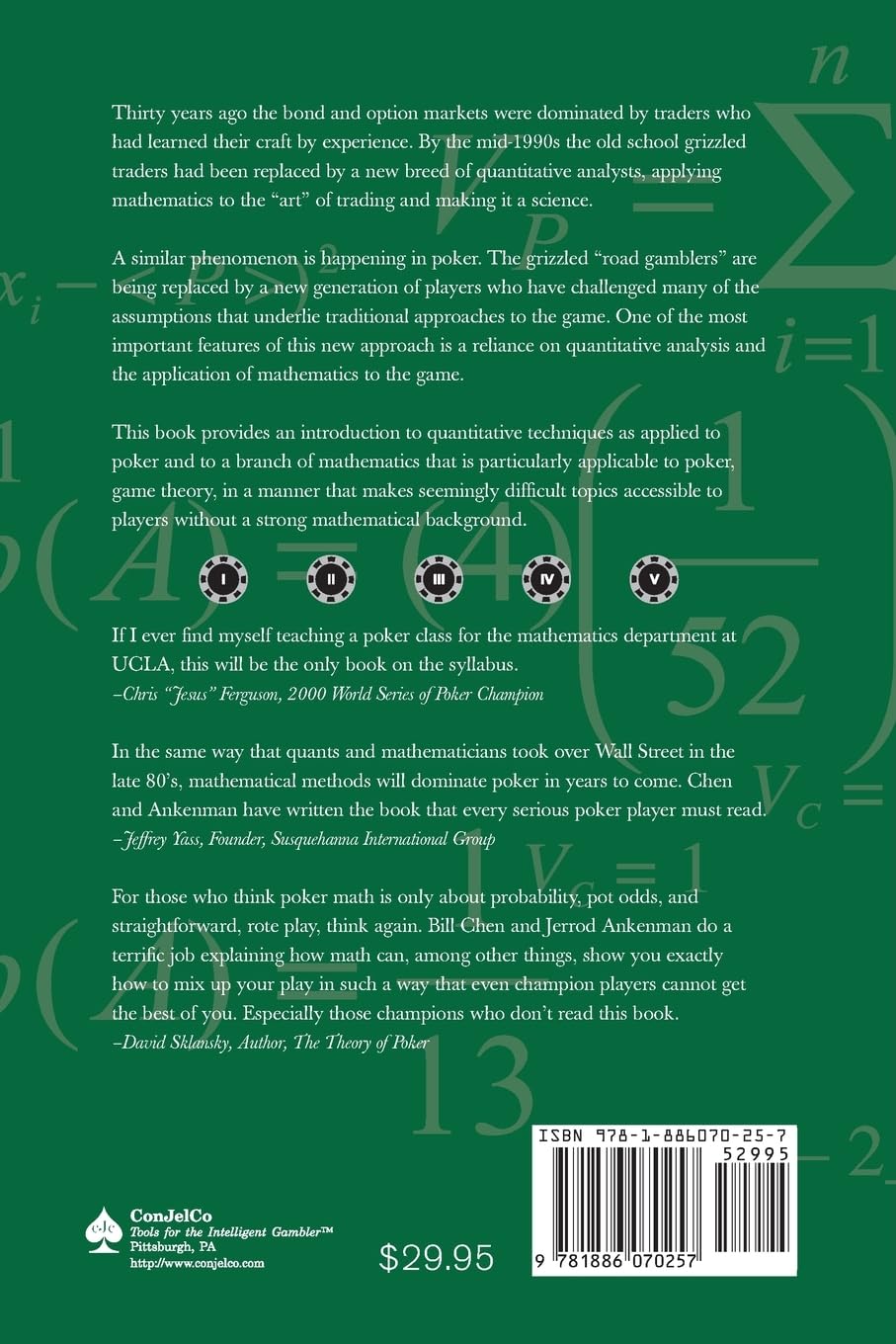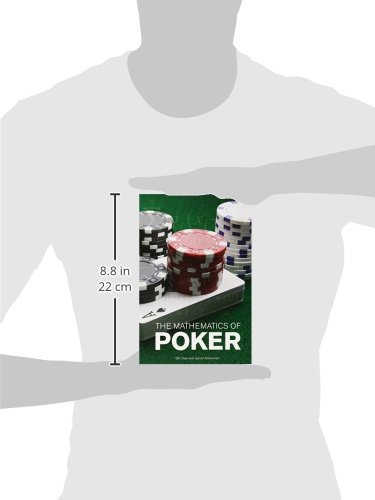



Full description not available
J**M
Bill, you gottta write a sequel
Wow, I'm very impressed with the book. I think it's touched ground that isn't available anywhere else. I'm sure that many programmers (myself included) have attempted to solve this game, and have discovered how burdensome the simple odds calculations are, nevermind the strategy and decision trees. Poker will not soon be solved by computers, like chess is. However, Bill Chen's ideas of "Toy games" help humans get insight into the character of the solution.Anyone picking up this text should be warned of several things:1) It is not for beginners. Strong poker takes judgement and experience, and basic hand/situational values cen be best learned from Dan Harringtons books or Sklansky's No-Limit book. I've read over 20 poker books, and Harrington and Sklansky stand out as the best. Harrington's books are very practical, with detailed analysis of situations.2) It is not for the timid, foggy headed, or undisciplined. The new concepts in his books require for you to stop and think. If your instinct is "gee, this sounds complicated", then give up now. Some people will have the same backlash that regular people have with math. If you're from the "Math is hard" philosophy, this is not for you.3) This book does not read fast. You should read it 3 times slower than a normal book to really appreciate it. The math shold not just be understood, it should be questioned.4) The book highlights theory behind game strategy, but does not connect the dots with real hands or real situations. It would be good to connect the check-call, check-raise, check-fold, bet-raise, bet-call, bet-fold, bluff, check-raise bluff, etc... thresholds with actual cards. What would be most cool is for software to perform this analysis, although I imagine only one-street analysis could be performed, but it would still be insightful.5) Personally, I cannot recommend the first 40 pages of this book. They really didn't dig into the meat of the game and I found it quite mundane.That said, here are the good things I can say about it:1) It is nothing like you've ever read in any other poker book before! Many poker books overlap eachother, reminding pot odds, hand values, tournament phases, etc. This book dives into the fundamental theory. The interesting math of poker is not related with mundane matters of probabilities, pot odds, etc. The interesting math is the math behind bluffing, calling, and value-playing. BTW, there is a math essay by Chris Ferguson about game theory and poker.2) It will remind you about why you bluff. One of the most practical lesson I learned from this math is that if you are bluffing optimally, YOU SHOULD BREAK EVEN ON YOUR BLUFFS! That was revolutionary for me. If you're winning on your bluffs, you're not bluffing enough. If you're losing, you're bluffing too much. If you break even, you get paid most on your value. This is not exclusively true, but becomes more true the more solid your opponent is. If your opponent is weak tight, then you should probably profit on your bluffs. Exploit appropriately.3) Optimal play gives you your "center game", which you use before you know your opponents. When you adapt to exploit your opponents, be aware that you are opening holes in your own game to perform the exploit.4) The material covered in this book is shore of an undiscovered land. It is only the beginning. Since the game appears unsolveable, there are riddles and puzzles at every corner. New insights can drive a stronger game. Who knows? You may have some clever insight beyond what the author discovered.I hope he writes a sequel to this book. Material I would love for him to research for the sequel:1) Preflop single-full-street play, but with real holdem. For a given bet-size some actual card thresholds would be given for bluff, check-fold, checkraise, bet-fold, bet-call, etc... Translate this basic game concept to card thresholds. Include the fact that hands only have equity, not some automatic ranking (like 0-1 game).2) Actual single-street post-flop play for some example flops. Again, card thresholds would be great. Ideally, if some representation could be shown for card thresholds as a function of bet & raise sizes. Maybe a few pages of tables are required. There should be at least 10 distinct flop examples and this should probably consume more than 30% of the book.3) Optimal exploit as a function of opponent's deviation from optimal play. Again, make it practical with card thresholds.4) The math of Caution vs. Aggression. I know that the deeper the stacks are, the more that play should steer towards caution. At 30 blinds, top pair is a push-push-push hand. At stack=pot middle pair is an allin hand. At 200 blinds, suddenly top pair seems like it should be sometimes checked, because it's tough to fold later. My question is, how does caution show up in the math? And how does it balance with the common notion that Aggressive play is best? I know it's often better to bet-fold a medium hand, but definately sometimes it's smartest to check-call it, to make your opponent indifferent to bluffing.5) The math suggests that you should be check-calling and bet-calling with some expected losers to make your opponent indifferent to bluffing. What is the real threshold for these check-calls? Are check-calls with 2nd pair smart? bottom pair? What is really the right threshold? How does this change with multiple "bullets"?6) The math suggests you should only bluff your trash. But then in multi-street poker with draws, we put many of our bluffs on medium drawing hands. How do the partially made hands with draws fit in?7) More analysis about mult-way pots. Try to solve the full street 3-way 0-1 game. In a multiway pot, which player will take the burden to bluff-call and make the opponent indifferent to bluffing?8) Any deeper material which cannot be described absolutely with math can probably be backed only by simulation. The readers are pragmatic people (just trying to improve their game) and do not need a systematic analysis for everything.9) Figure out every secret that Chris Ferguson knows and squeeze it in here! lolI very much believe there needs to be a sequel to this book. A foundation was layed, but the dots were not completely connected together. It's kinda like a movie where you're left in the middle, waiting for the sequel. The theory needs to be grounded to some practice.
B**C
Challenging but Superb.
I finished this book last week and was pretty amazed. I think, at least for non-mathematic experts like this reviewer, going through it a couple more times is the best way to make use of the author's endeavor. This book is not huge but its pages are swelled with information. It is broken down into five major parts; each of these support the central theme of maximizing average profit. By the second page of the Introduction--in which the common misconceptions of play are examined--readers will discern that there is no fluff in these 350+ pages. Parts II and III embody its intellectual core as they outline the mechanics of both exploitative and optimal play. Exploitative play is defined as maximizing expectation in lieu of your opponent's strategy; whereas, optimal play makes use of fundamentally sound strategies which are independent from your opponent's actions. While most players strive to be exploitative with their play, the better ones compete at a "near-optimal" level which is an evolutionary advancement over taking advantage of mistakes. Other than Roshambo [rock, paper, scissors] and the The Jam or Fold Game for no limit, many examples will not be familiar to the average person. A lack of familiarity is not a problem, however, because studying games like Clairvoyance, AKQ, Cops and Robbers, and Auction strengthen the mind and provide valuable perspective. Of course, novices should be forewarned to put off this purchase until they become fully grounded in the elementary facets of poker. This text does not address the majority of the decisions one makes at the table. In this way, Chen and Ankenman are more Plutarch than Sklansky by treating the mind as "a fire to be kindled, not a vessel to be filled."Poker fans may be worried about the difficulty of the math presented, and whether or not the possession of serious quantitative skills mandatory for getting something out of it. Not surprisingly, the answer is, "It depends." Assuredly, most members of the book consuming poker public meet the author's criteria in this area, which is the completion of eighth grade algebra. Although, what Chen and Ankenman may forget is that many of us no longer remember most of what we learned during those dark days of middle school. Understanding the proofs so prevalent hinges on the retention of information that might have been long deleted from our memory banks. Furthermore, a rudimentary background in statistics is also necessary for apprehending the meaning behind the equations. Those with no knowledge of statistics and algebra will be slightly stunned by the extent of the quantitative detail on display. The math impaired might become slightly demoralized, but the good news is that some amazing ideas are presented above and below the ubiquitous expressions. The sections concerning bankrolls, backing agreements, and tournaments will be of value to everyone as will the chapters devoted to the Risk of Ruin model, the use of math to improve play, and a no limit hold `em case study used as the basis for justifying the precepts of game theory.Yes, this book is quite challenging, but self-improvement is rarely accomplished via easy endeavor. It is important to recall that this text is not an end point. Mountain ranges worth of mathematical information remain in need of interpretation. The Mathematics of Poker is a thorough introduction, and there is little doubt that future works will build upon its foundation. Chen and Ankenman offer something here that is totally unique due to its avoidance of felt level tactics and its emphasis on strategy--which is its essential virtue.
D**Y
Excellent content - difficult read!
Although this book was first published in 2006, all of it's content is still applicable today in 2013, which is when I first decided to read it. All of the math content in this book is a must-know if you want to crush poker. I have read over 20 poker books and watched over 100 poker training videos. I have a degree in Computer Engineering and math is my strong point - THIS WAS A TOUGH BOOK TO READ! The reason it was tough was because of all the math proofs. If you've ever taken a college calculus course, usually your professor will go over the proofs in class, step-by-step, and you can follow along and ask questions and the final result makes sense. Reading this book is like picking up a calculus book and trying to learn it on your own. If you are like me and have trouble following along with the proofs, then you may just want to skip to the results in some of the chapters. The results are golden, even if you just have to take on blind faith that the authors proofs are indeed accurate, which I believe they are. Chapters 10 through 21 are the meat of this book, and the basis for Game Theory in Poker, which is the #1 reason I bought this book. 5 Stars for Content, 3 Stars for readability.
Trustpilot
1 month ago
1 day ago